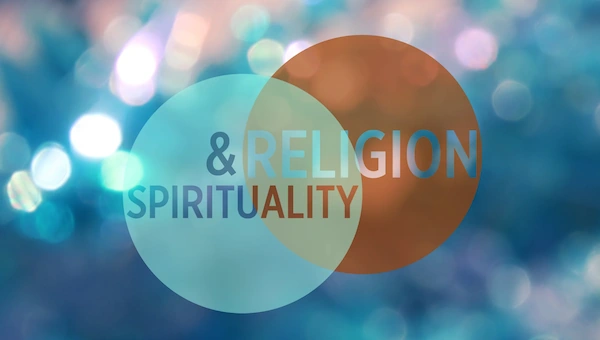
🎧 LISTEN TO THIS ARTICLE 🎧
While religion and spirituality both address humanity’s deepest yearnings for transcendence, they shape fundamentally different psychological orientations and ways of being in the world. One creates complexity through elaborate systems of rules and prohibitions; the other seeks simplicity through direct experience and inner liberation. Understanding these differences reveals not just intellectual distinctions but profoundly different approaches to human flourishing.
The Psychology of the Religious Individual
The Architecture of External Authority
The religious person constructs their identity around external structures—sacred texts, institutional teachings, clerical authority, and communal consensus. This creates what we might call an “externalized conscience,” where moral decisions are guided primarily by established doctrine rather than inner discernment.
Lao Tzu observed over 2,500 years ago: “When people see some things as beautiful, other things become ugly. When people see some things as good, other things become bad.” The religious mindset often operates through such dualistic categories—sacred versus profane, permitted versus forbidden, orthodox versus heretical. This binary thinking provides psychological security but can limit the flexibility needed for authentic moral reasoning.
The religious individual finds comfort in what the Buddha called “the refuge of rules.” They know precisely what to do in most situations because the path has been mapped by generations of believers. Sunday worship, Friday prayers, Sabbath observance, dietary laws, marriage customs—these create a comprehensive framework for living that reduces existential anxiety through certainty.
The Burden of Complexity
Yet this certainty comes at a psychological cost. Consider the elaborate kosher laws in Judaism with their hundreds of specific regulations, or the detailed ritual prescriptions in orthodox Christianity, or the comprehensive legal code (Sharia) in traditional Islam. The Talmud famously contains 613 commandments governing Jewish life—a number that reflects the religious tendency toward ever-increasing specificity and complexity.
Marcus Aurelius, though writing as a Stoic philosopher, captured this psychological burden: “How much trouble he avoids who does not look to see what his neighbor says or does, but only to what he does himself.” The religious person, by contrast, must constantly monitor not only their own actions but their conformity to communal expectations and institutional requirements.
This creates what modern psychology would recognize as “cognitive load”—the mental energy required to navigate complex rule systems. The devout religious practitioner must remember which foods are permitted, which prayers are required at which times, which social interactions are appropriate, which thoughts are sinful. This mental complexity can paradoxically distance one from the very spiritual reality the rules were meant to cultivate.
The Psychology of Submission
The religious temperament is fundamentally oriented toward submission—to God, to scripture, to religious authority, to community consensus. This submission can produce profound psychological benefits: a sense of belonging, clear moral guidance, relief from the burden of making ultimate decisions about life’s meaning.
The Quranic concept of islam itself means “submission,” and similar themes appear across traditions. The Christian speaks of surrendering to God’s will, the Buddhist takes refuge in the Buddha, Dharma, and Sangha, the Hindu follows the guidance of the guru and sacred texts. This psychological stance of receptivity and obedience can cultivate humility and selflessness.
However, Epictetus warned about the danger of “living according to the opinions of the multitude.” When submission becomes unconscious conformity, it can stunt psychological development and authentic self-discovery. The religious individual may never fully discover their own capacity for wisdom and moral discernment.
The Psychology of the Spiritual Individual
The Liberation from External Authority
The spiritual person operates from what we might call an “internalized wisdom”—a direct relationship with truth that bypasses institutional mediation. As the Zen saying puts it: “If you meet the Buddha on the road, kill him”—meaning that any external spiritual authority, no matter how revered, must ultimately be transcended for authentic realization.
This represents a fundamental psychological shift from external validation to inner authority. The spiritual individual develops what Carl Jung called “individuation”—the process of integrating all aspects of the personality around a center that transcends both ego and social conditioning.
Heraclitus declared: “The path up and down are one and the same.” For the spiritual person, this means that apparent opposites—good and evil, sacred and profane, self and other—are recognized as interdependent aspects of a unified reality. This non-dualistic awareness frees them from the psychological burden of constant moral categorization.
The Simplicity of Direct Experience
Where religion multiplies rules and regulations, spirituality seeks the essence beneath all rules. Chuang Tzu illustrated this with his story of the master woodcarver who was commissioned to create a bell stand for the temple. Rather than forcing his will upon the wood, he first fasted and meditated until his mind became still. Only then did he enter the forest, where he found a tree whose natural form already contained the perfect bell stand. His carving simply revealed what was already present, working in harmony with the wood’s inherent nature rather than imposing external technique upon it.
The spiritual individual seeks this same seamless flow in life itself. Rather than consulting external authorities for guidance, they cultivate inner listening—what Quakers call “waiting upon the Light” or what mystics across traditions describe as “the still small voice within.”
This creates a psychological orientation toward simplicity and immediacy. As Plotinus wrote: “The One is not absent from anything and yet separate from all things, so that it is present and not present at the same time.” The spiritual person learns to recognize this ever-present awareness that requires no special conditions, rituals, or institutional frameworks to access.
The Freedom from Psychological Bondage
Patanjali, in the Yoga Sutras, defined enlightenment as the cessation of mental fluctuations (chitta-vritti-nirodha). This points to spirituality’s fundamental concern with psychological liberation—freedom from the conditioned patterns of thought and emotion that create suffering.
The spiritual individual recognizes what the Buddha called the “proliferation” (papañca) of mental activity—the way the mind creates endless complexity through conceptual elaboration. Instead of adding more rules and beliefs, they practice what Lao Tzu called wu wei—effortless action that flows from natural wisdom rather than forced compliance.
This psychological stance produces remarkable inner freedom. As Marcus Aurelius noted: “You have power over your mind—not outside events. Realize this, and you will find strength.” The spiritual person discovers that peace comes not from controlling external circumstances through religious observance, but from recognizing the unchanging awareness in which all experiences arise and pass away.
✨ Spiritual Awakening Test
Explore the profound transformation of consciousness where your spiritual essence begins to transcend the limitations of material existence. This assessment helps clarify your position on the journey from materiality to spirituality—the process where the mind, with its ego-based limitations, gradually gives way to your multidimensional nature.
Through 27 thoughtfully crafted questions, this test identifies common stages experienced during this transformation, with particular focus on the disillusionment phase that precedes the reevaluation of previously taken-for-granted assumptions.

❓27 questions
💬 5 possible answers
☯️ 6 potential awakening stages
The Paradox of Spiritual Authority
Paradoxically, by abandoning external authority, the spiritual individual often discovers genuine authority within. Rumi expressed this beautifully: “Yesterday I was clever, so I wanted to change the world. Today I am wise, so I am changing myself.” This shift from outer manipulation to inner transformation represents the core of spiritual psychology.
The spiritual person learns to trust what Socrates called the daimonion—the inner voice or guiding intelligence that speaks without words. This is not the ego’s voice with its endless desires and fears, but what various traditions call the Self, Buddha-nature, or Atman—the essential awareness that is our deepest identity.
Psychological Contrasts in Daily Life
Decision-Making: Rules vs. Intuition
Consider how religious and spiritual individuals approach moral decisions differently. The religious person consults authorities: What does scripture say? What do the clergy teach? What would the community approve? This external validation provides security but can disconnect one from their own moral intuition.
The spiritual individual, following Socrates’ maxim “know thyself,” turns inward to what feels authentically aligned with truth and compassion. They recognize, with Lao Tzu, that “when people see some things as beautiful, other things become ugly,” and thus seek to act from a place beyond such conditioned preferences.
A religious person might avoid certain foods because they are forbidden; a spiritual person might avoid the same foods because they intuitively sense what serves their well-being. The external behavior might be identical, but the psychological orientation is fundamentally different—one based on compliance, the other on wisdom.
Relationship to Suffering: Acceptance vs. Resistance
The religious individual often views suffering through the lens of divine will or karmic consequence—something to be endured, atoned for, or overcome through proper observance. This can create psychological resistance to difficult experiences and a sense that suffering indicates spiritual failure or divine displeasure.
The spiritual individual, influenced by insights like those of the Buddha on the inevitability of suffering or the Stoic understanding of acceptance, learns to meet difficulties with what Pema Chödrön calls “loving-kindness toward our own experience.” They recognize suffering as a teacher rather than an enemy, finding in it opportunities for deeper understanding and compassion.
Identity: Collective vs. Individual
The religious person derives identity primarily from group membership—I am a Christian, Muslim, Jew, Hindu, Buddhist. This provides psychological security and social connection but can also create what Jung warned against: identification with the collective persona rather than authentic individuality.
The spiritual individual, while honoring the wisdom of traditions, ultimately identifies with what Ramana Maharshi called the “I AM” that exists prior to all labels and categories. This shift from “I am this” to simply “I am” represents a fundamental psychological liberation from conditional identity.
As Plotinus observed: “When the soul knows itself, it knows also that its movement is not in a straight line… but it circles around something, around a center.” This center is not a religious identity but the pure awareness that is our essential nature.
The Shadow of Each Approach
Religious Shadows: Rigidity and Projection
The religious psychology, while offering valuable structure and community, can devolve into what we might call “spiritual materialism”—using spiritual practices and beliefs to strengthen rather than dissolve the ego. The Pharisees whom Jesus criticized exemplified this tendency: outwardly observant but inwardly disconnected from the love and compassion that religious practice is meant to cultivate.
Seneca warned against this spiritual pride: “It is a shameful thing to be weary of inquiry when what we search for is excellent.” The religious person may become so attached to their particular forms and beliefs that they stop genuinely seeking truth.
Spiritual Shadows: Isolation and Bypassing
The spiritual psychology, while offering profound inner freedom, can lead to what Chögyam Trungpa called “spiritual materialism” of a different kind—using spiritual practices to avoid rather than engage with the challenges of human existence. This includes what psychologist John Welwood termed “spiritual bypassing”—using spiritual ideas to avoid psychological healing and emotional integration.
The ancient Stoics recognized this danger. As Epictetus taught: “Don’t explain your philosophy. Embody it.” The spiritual person may become so absorbed in inner experiences that they neglect their responsibilities to family, community, and society.
Ancient Wisdom on Integration
The Middle Way
The Buddha’s Middle Way offers profound psychological wisdom for integrating religious structure with spiritual freedom. Having tried both extreme asceticism (similar to rigid religious observance) and indulgence (similar to ungrounded spiritual seeking), he discovered that genuine liberation required balancing discipline with flexibility, effort with ease, community with solitude.
This suggests that psychological maturity might involve drawing from both religious and spiritual resources—maintaining connection to wisdom traditions while cultivating personal discernment, honoring community while trusting inner guidance, following beneficial practices while remaining free from compulsive adherence to rules.
The Perennial Philosophy
Aldous Huxley’s concept of the “perennial philosophy”—the common core of truth underlying all religious traditions—points toward a psychology that honors both the diversity of religious expression and the unity of spiritual realization. From this perspective, religious forms serve as skillful means for cultivating the spiritual consciousness that ultimately transcends all forms.
As Meister Eckhart expressed it: “God is at home, it’s we who have gone out for a walk.” Both religious observance and spiritual practice can serve as ways of returning home to our essential nature—one through established pathways, the other through direct recognition.
Practical Implications for Modern Seekers
The Integrated Approach
Perhaps the most psychologically healthy approach involves what we might call “spiritual maturity”—the ability to engage religious forms without being trapped by them, to honor tradition while maintaining inner freedom, to participate in community while trusting personal wisdom.
This integration recognizes that humans need both roots and wings—the grounding that comes from connection to established wisdom and the freedom that comes from direct spiritual realization. As Rumi wrote: “Sell your cleverness and buy bewilderment.” This bewilderment is not confusion but the wonder that arises when we recognize the mystery that underlies both religious devotion and spiritual seeking.
The Evolution of Consciousness
From a developmental perspective, individuals may naturally move through religious phases toward greater spiritual autonomy. Children often benefit from the security of religious structure, adolescents may rebel against external authority, young adults might explore various spiritual practices, and mature individuals may integrate the best of both approaches.
This evolution reflects what the ancient Greeks called metanoia—a transformation of consciousness that goes beyond mere belief change to fundamental shifts in how we experience reality itself.
Conclusion: Two Medicines for the Human Condition
Both religious and spiritual approaches serve as medicine for the human condition, but they treat different aspects of our existential predicament. Religion addresses our need for belonging, structure, and collective wisdom. Spirituality addresses our need for freedom, authenticity, and direct truth.
The religious individual finds peace through surrender to established order; the spiritual individual finds peace through surrender to present-moment awareness. The religious person seeks salvation through proper observance; the spiritual person discovers that what we seek is always already present.
As Lao Tzu observed: “The sage is guided by what he feels and not by what he sees.” Yet we might add that wisdom sometimes requires both feeling and seeing—the inner sensitivity of spiritual awareness and the outer guidance of tested religious wisdom.
Perhaps the deepest truth is that both approaches point beyond themselves to a reality that can neither be captured in rules nor grasped through experience alone. In recognizing this, we find a freedom that encompasses both the security of religious faith and the liberation of spiritual awakening—a freedom that is both deeply personal and universally accessible, both profoundly simple and mysteriously complex.
The journey continues, and both the religious and spiritual paths offer essential gifts to those seeking authentic transformation in service to the healing and awakening of our world.
Questions for Self-Reflection
- Do you find more peace in following established guidelines or trusting your inner wisdom? What does this reveal about your psychological orientation?
- How do you experience the difference between outer compliance and inner alignment in your daily choices?
- What would it mean to be both grounded in wisdom tradition and free from psychological bondage to external authority?
- How might the apparent tension between religious structure and spiritual freedom actually serve your deepest development?
🎁 Spiritual Gifts & Talents Test
Unveil your soul’s sacred purpose by identifying your unique spiritual endowments. These gifts—whether wisdom that illuminates darkness, creativity that brings beauty from chaos, empathy that heals wounded hearts, or leadership that transforms communities—are sacred threads woven into the fabric of your soul.
Drawing from humanity’s great wisdom traditions, this assessment explores 17 distinct spiritual gifts, each representing a different facet of divine expression through human experience.

❓25 questions
💬 5 possible answers
👤 17 different gifts/talents
ARE YOU A MORALLY WHOLE PERSON?
The term “morally whole” is used to describe an individual who exhibits a consistent alignment between their actions, beliefs, and values. This entails an internal consistency whereby one’s ethical principles are not only comprehended, but also serve as a guiding force in navigating various circumstances. It necessitates a profound self-awareness and the capacity to reflect on one’s moral decisions, ensuring that they are not unduly influenced by external pressures or personal gain, but remain consistent with one’s fundamental ethical standards. An individual who is morally whole demonstrates empathy and takes into account the impact of their actions on others. They strive to contribute positively to society while respecting diverse perspectives. Finally, moral integrity involves a commitment to continuous moral growth. This entails acknowledging that one’s understanding of morality can evolve with new experiences and insights. As a result, such an individual maintains an openness to learning and adapting their moral framework.
Examine the statements provided below and pick the ones you fully agree with.
Sum up the selected boxes and check the related profile.
0: You are not morally whole at all
1-2: You are poorly morally whole
3-4: Your moral integrity is fluctuating
5-6: You are a person of moral integrity
Further details on moral integrity



